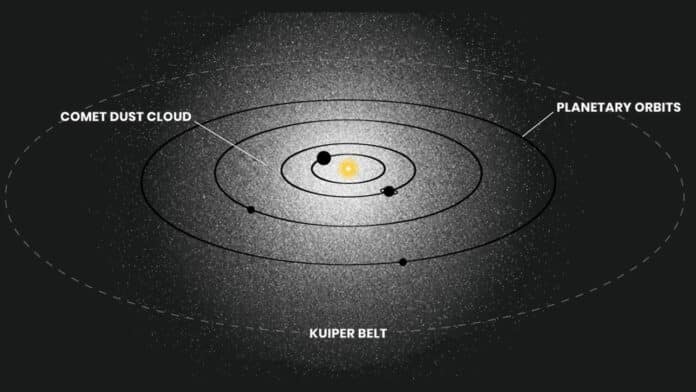To hunt for any residual background glow in the sky- in an ambitious project called SKYSURF- astronomers examined 200,000 Hubble Space Telescope archived images and took tens of thousands of measurements on these images. They eliminated the light from stars, galaxies, planets, and the zodiac light, much like shutting out the lights in a room. Surprisingly, there was still a faint, weak glow.
What causes this ghostly glow throughout our solar system?
One hypothesis is that sunlight is reflected by the dust layer surrounding our solar system to Pluto. Due to the glow’s even distribution, numerous comets—free-flying, dusty snowballs of ice—are the most plausible source. As they descend toward the Sun from all angles, the heat from the Sun causes the ice to sublimate, releasing a cloud of dust in the process.
This would represent a brand-new piece of the solar system’s architecture if confirmed. It remained invisible until very imaginative and curious astronomers and the power of Hubble came along.
This theory is supported by the fact that another group of astronomers measured the sky backdrop in 2021 using information from NASA’s New Horizons probe. The New Horizons spacecraft recently entered interstellar space after passing by Pluto in 2015 and a small Kuiper belt object in 2018. 4 to 5 billion kilometers separated New Horizons from the Sun when the observations were taken. The planets and asteroids, where there is no pollution by interplanetary dust, are far away from this.
Tim Carleton of Arizona State University (ASU) said, “New Horizons detected something a bit fainter that is apparently from a more distant source than Hubble detected. The source of the background light seen by New Horizons also remains unexplained. Numerous theories range from the decay of dark matter to a huge unseen population of remote galaxies.”
“If our analysis is correct, there’s another dust component between us and the distance where New Horizons made measurements. That means this kind of extra light comes from inside our solar system.”
“Because our measurement of residual light is higher than New Horizons, we think it is a local phenomenon not from far outside the solar system. It may be a new element to the contents of the solar system that has been hypothesized but not quantitatively measured until now.”
Hubble veteran astronomer Rogier Windhorst said, “More than 95% of the photons in the images from Hubble’s archive come from distances less than 3 billion miles from Earth. Since Hubble’s very early days, most users have discarded these sky photons, as they are interested in the faint discrete objects in Hubble’s images, such as stars and galaxies. But these sky-photons contain important information which can be extracted thanks to Hubble’s unique ability to measure faint brightness levels to high precision over its three decades of a lifetime.”
Journal References:
- Timothy Carleton, Rogier Windhorst, et al. SKYSURF: Constraints on Zodiacal Light and Extragalactic Background Light through Panchromatic HST All-sky Surface-brightness Measurements: II. First Limits on Diffuse Light at 1.25, 1.4, and 1.6 μm. The Astronomical Journal. DOI: 10.3847/1538-3881/ac8d02
- Rogier Windhorst, Timothy Carleton, et al. SKYSURF: Constraints on Zodiacal Light and Extragalactic Background Light through Panchromatic HST All-sky Surface-brightness Measurements. I. Survey Overview and Methods. The Astronomical Journal. DOI: 10.3847/1538-3881/ac82af
- Darby M. Kramer, Timothy Carleton, et al. SKYSURF-3: Testing Crowded Object Catalogs in the Hubble eXtreme Deep Field Mosaics to Study Sample Incompleteness from an Extragalactic Background Light Perspective. The Astrophysical Journal Letters. DOI: 10.3847/2041-8213/ac9cca
